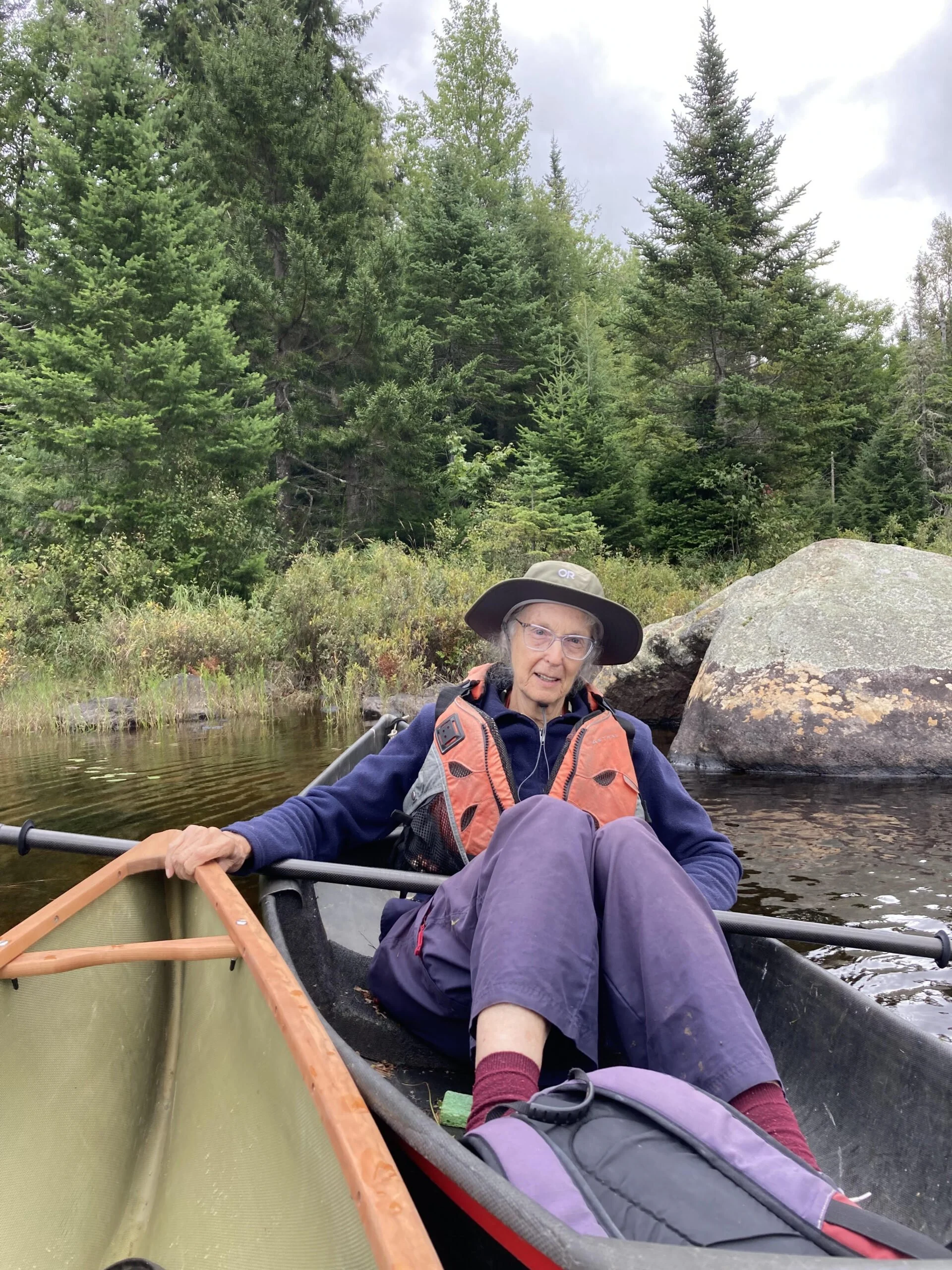Evelyn Greene, Denizen of the Forest Preserve, 1940 - 2025
A couple of years ago, my partner Amy and I led a treasured guest on a bushwhack towards our inholding deep in the High Peaks. Two miles of not inconsiderable effort, passing upward through several forest types leads to a remarkable series of waterfalls and cascades situated in a deep, perennially dripping cleft. It’s a gorgeous wilderness hike and our friend reveled in every bit of it. At that point in her early 80’s, she reached the falls with moxie to spare despite the thousand-foot elevation gain and the numerous logs, brush, and other obstacles along the herd path. True, the pace on the way was glacial, not so much because of her age, but rather because every thirty feet she and Amy would stop to admire and discuss some moss or fern. Our friend’s forest speed was only ever sauntering, as the legendary John Muir would have described it (Muir felt that sauntering was the only acceptable way to walk in wilderness). Her paddling speed was comparable – drifting, one might say, were it not so purposeful.
On the way out we paused at a large log crossing the herd path and she directed my attention to some deposits the size of Cheetos, lying atop the log.
“Do you know what that is?”
“No, I guess I don’t.”
“WHY NOT!?”
In two words my bona fides as an Adirondack woodsman were eviscerated, and in the most delightful, earnest, and enthralled-with-nature manner. That was Evelyn Greene.
I do my share of writing, but honestly, I cannot find the right vocabulary to describe Evelyn. The task of sharing what she was like is simply beyond my skill. She certainly earns one perennially-overused adjective: unique. Evelyn Greene was as unique as anyone I’ve ever met. She had an old-school 1940’s-era independent-woman style to her, which is already an odd attempt to describe her, because Evelyn had no discernable interest whatsoever in style of any kind. Yet she had it – naturally, authentically and wholly-owned. It was just who she was. The best illustration I can offer is that Evelyn was reminiscent of Kathyrn Hepburn, but more innocent – Hepburn simultaneously as powerful adult and inquisitive child. Ev was idiosyncratic, opinionated, fascinated with the natural world, immovably affixed to the ideas she thought mattered, terribly bright, immensely patient with nature and equally impatient with dullards. One might at first think Ev was not affectionate, sentimental, or romantic. Yet those of us who came to adore her (and oh how we did) understood that she was in fact deeply affectionate, sentimental, and romantic. It was just in her own way, on her own terms, and always with impeccable integrity. This was a person whose capacity for caring was sterling. With her passing the world will dimmish a little. The Adirondacks, which she fought for and defended all her life, will suffer her loss.
Evelyn Greene
It's almost beside the point that Evelyn was Adirondack royalty. Her father was Paul Schaefer, one of the most important Adirondack preservationists of the twentieth century. Both Adirondack Wild and PROTECT, upon whose board Evelyn served, are direct products of Paul Schaefer’s activism, along with large portions of the Adirondacks that aren’t submerged by dams. Like her father, Evelyn was a fierce defender of the most traditional version of wilderness: no trammeling, no motors, no mechanization, no nonsense.
Right up to her last days Evelyn would talk with us in her living room, and at every visit without fail there would be a stack of articles, news clippings or maps waiting for us, relevant to some Adirondack matter of importance or some Adirondack plant to be studied and loved. We never stopped learning from her. Ev was an expert on mosses, rock formations, forest types, rivers (she lived along the Hudson), ice, and bogs. Amy has a solo canoe because of Evelyn. Amy is becoming proficient in mushrooms and fungi and mosses and such because of Evelyn. Amy’s not the only one: Ger Cox, Bonnie Vicki, Lorraine Duvall, Nancy Bernstein, all paddlers, all lovers of bogs and inlets and ponds, all defenders of the Adirondacks… these women were Evelyn’s posse, spread out in every corner of the park. Men too: John Davis, Peter Bauer, Dave Gibson, myself, many more. Reflect for a moment that the names I listed include some of the most well-known defenders of Adirondack wilderness. That should give you a pretty good idea of how important Evelyn Green was. All of us, sometimes separately, sometimes together, will consciously go out there and act for this place we all love in ways that continue her spirit. Evelyn knew the Adirondacks as well as anyone alive. We all get the privilege of carrying her legacy onward. It won’t take much effort: it will just happen. Like she did it.
Evelyn was a superb amateur botanist and naturalist, and as such knew the formal Latin names for many of the region’s plants. Amy was going to name her new solo canoe “Sotto Voce;” now she is favoring “Quidni?”
“Quidni?” is Latin for “Why not?”

